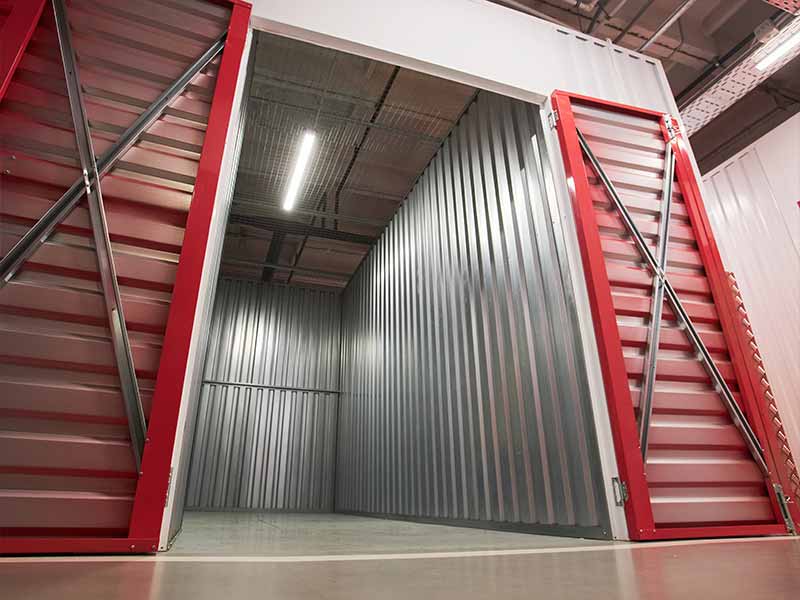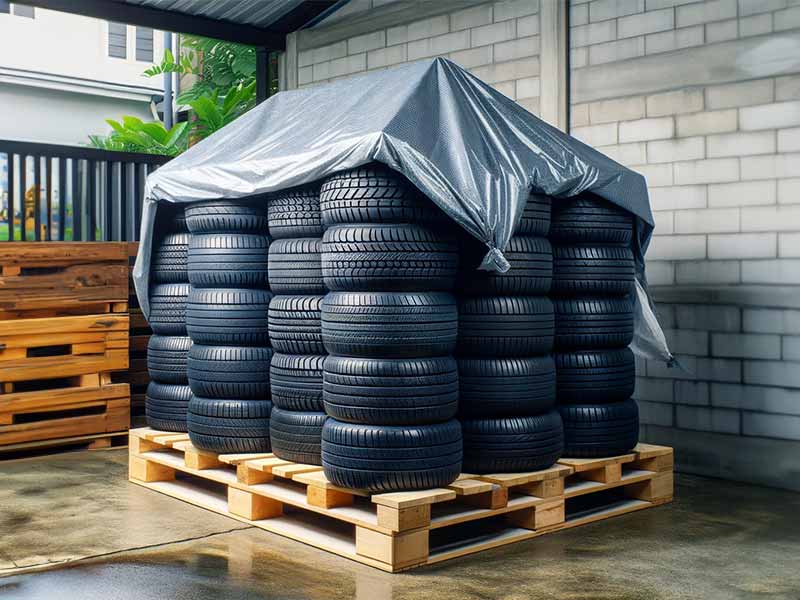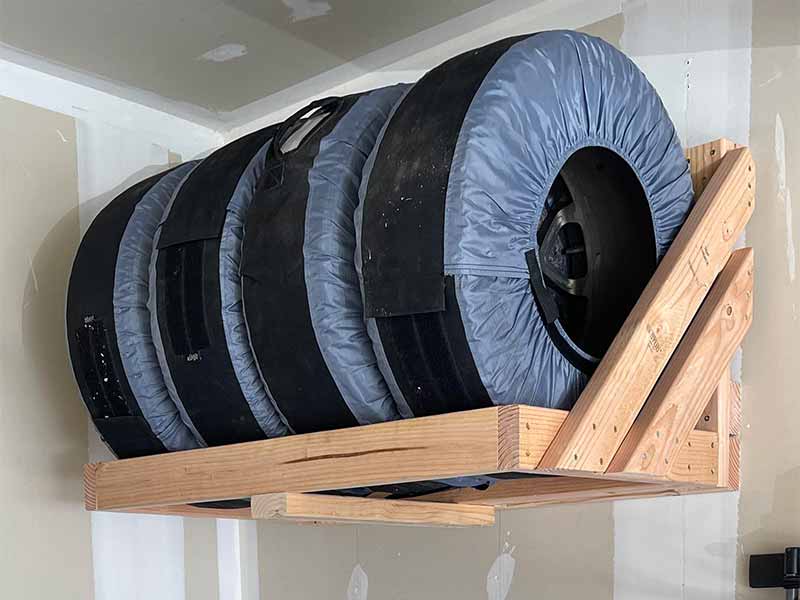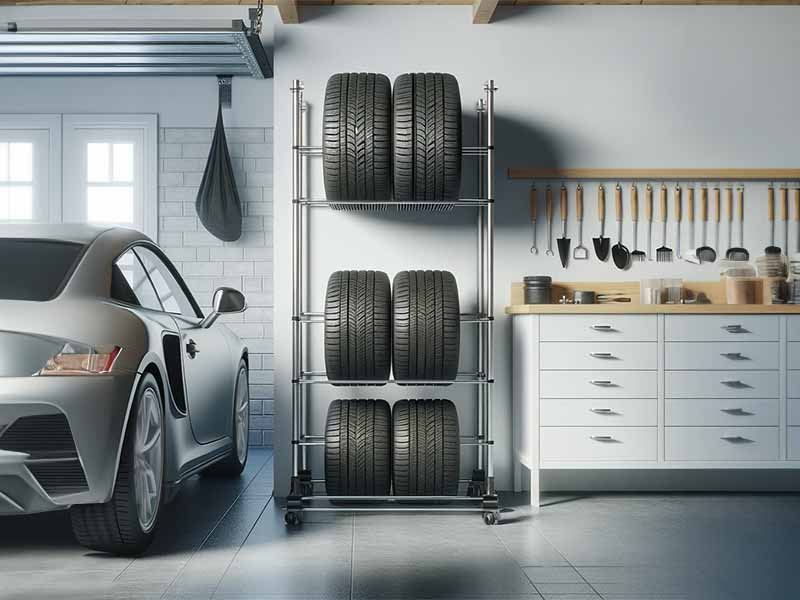Are you staring at your summer tires, wondering where they’ll hibernate until the snow melts? You’re not alone. As temperatures drop, every car owner faces the seasonal puzzle of tire storage. Whether you’re in a cozy apartment, a house without a garage, or lucky enough to have a spacious garage, this article is your roadmap to storing tires in winter.
Where To Store Tires During Winter
The best places to store tires during winter are in a cool, dry, and dark space like a garage, basement, or a climate-controlled storage facility. If these options aren’t available, proper preparation and protective coverings are key to preserving tire condition.
In this article, we’ll explore practical and accessible tire storage solutions tailored to different living arrangements, from garages and basements to apartments and even outdoor settings. We’ll cover the essentials of maintaining tire integrity, maximizing space, and ensuring your tires are road-ready for the next season.

Tire Storage Basics
Like any other vehicle component, tires need the right environment to ensure they stay in good shape and serve you well for as long as possible. Let’s dive into the what and why of tire storage.
The Ideal Conditions for Tire Storage
Getting the environment right for tire storage is like finding the sweet spot for wine aging. Here are the key factors:
- Temperature: Tires prefer a cool, not cold, and consistent temperature. Think about conditions similar to a wine cellar – around 50-70°F (10-21°C).
- Humidity: Dry conditions are best. Excessive moisture can lead to tire degradation over time.
- Sunlight: UV rays are not tire-friendly. Store your tires away from direct sunlight to prevent them from drying out and cracking.
- Cleanliness: Ensure tires are clean and dry before storing to avoid mildew or other damage.
Preparing Your Tires for Storage
Before you tuck your tires away for the winter, give them a little TLC.
- Cleaning: Wash off any dirt, grime, or brake dust with soap and water. Dry thoroughly.
- Inspection: Check for any damage or irregular wear and address any issues before storing.
- Storage Bags: If possible, place each tire in an airtight bag to reduce exposure to oxygen and ozone.
Storing Your Tires: The Basics
- Position: Ideally, tires should be stored vertically (on their treads) if they’re mounted on rims and stacked horizontally if they’re not. This helps maintain their shape.
- Rotation: If you’re storing them for an extended period, rotate the tires now and then to prevent flat spots.
- Elevation: Keep tires off the ground on a rack or shelf to protect them from moisture and pests.

Storing Tires in a House with a Garage
Having a garage can make winter tire storage simpler and more convenient. It’s a ready-made environment that, with a few tweaks, can be ideal for keeping your tires in top-notch condition during the off-season. Here’s how to maximize this space for tire storage.
Creating the Perfect Garage Environment
Even if you have a garage, it’s important to ensure it’s set up to keep your tires happy.
- Temperature Control: Insulate your garage if possible to keep the temperature consistent and cool.
- Humidity Levels: Consider a dehumidifier if your garage tends to get damp.
- Sunlight Protection: Keep tires away from windows or any direct sunlight.
How to Store Tires in Your Garage
- Vertical vs. Horizontal: If the tires are mounted on rims, stand them upright. If they’re unmounted, it’s better to stack them flat. Here’s why:
- Mounted (with rims): Standing upright avoids unnecessary stress on the tires.
- Unmounted (without rims): Laying flat distributes the tire’s weight evenly and prevents shape distortion.
- Racking Up: Use tire racks or shelves to keep tires off the ground. This protects them from moisture and potential ground chemicals.
- Cover Up: Use tire covers or bags to shield them from dust, dirt, and accidental spills.
Regular Check-Ups
Even in storage, tires need a little attention now and then.
- Inspection: Periodically check the tires for any signs of damage or wear.
- Rotation: If you’re storing them for several months, rotate the tires to prevent flat spots.
Making the Most of Your Space
Garages often double as storage for many other things. Here’s how to keep your tires accessible and safe:
- Organized Layout: Designate a specific area for tire storage. Keep it clear from potential hazards or heavy items that might fall onto the tires.
- Accessibility: Store tires in a way that they are easy to access when it’s time to put them back on your vehicle.
Safety First
- Keep Away from Oils & Chemicals: Ensure that tires are stored away from solvents, fuels, and lubricants as these substances can deteriorate rubber over time.
- Child & Pet Safety: Ensure the tire storage area is safe and inaccessible to children and pets.

Solutions for Houses without a Garage
Not having a garage doesn’t mean you can’t store your tires safely and effectively through the winter. There are several smart and creative solutions to protect your tires even if you lack the traditional storage space. Let’s explore the options and how to make the most of them.
Using a Shed or Basement
If you have a shed or basement, these can be great alternatives to a garage.
- Temperature and Humidity Control: Like a garage, ensure these spaces are cool and dry. Use insulation or a dehumidifier if necessary.
- Organization: Use shelves or racks to keep tires off the ground and organized.
- Protection: Cover tires with bags or sheets to protect them from dust and pests.
Inside the House
It might seem unconventional, but storing tires inside your home is a viable option, especially if you live in a mild climate.
- Choosing the Right Spot: A closet, utility room, or under the stairs can be suitable. Ensure it’s a dry and cool area, away from living spaces due to the tires’ smell and dirt.
- Safety Measures: Keep the tires clean and cover them to prevent any dirt or rubber smell from spreading.
Alternative Solutions
If you’re limited on space or need a temporary solution, consider these ideas:
- Rental Storage Units: Renting a small storage unit specifically for tires and other seasonal items can be cost-effective and secure.
- Tire Hotels: Some service centers or tire shops offer a tire storage service, known as a “tire hotel.” They’ll store your tires for a fee.
Storing Tires Cheaply and Effectively
No garage? No problem. Here’s how to store your tires on a budget:
- DIY Racks: Build or repurpose shelving units to store your tires efficiently.
- Utilize Wall Space: Consider wall-mounted solutions to keep tires off the floor and save space.
- Bag Them Up: Use large, durable bags to protect the tires from dust and moisture.
Tips for Maintaining Tire Condition
Regardless of where you store your tires, maintaining their condition is key.
- Regular Inspection: Even in storage, check your tires periodically for any issues or damage.
- Proper Cleaning: Clean the tires before storing them to prevent any dirt or oils from causing damage over time.
- Optimal Positioning: Store tires based on whether they’re mounted or unmounted, as detailed in previous sections.
What About Outdoor Storage?
Storing tires outside is not ideal due to exposure to elements, but if it’s your only option:
- Cover and Elevate: Use a waterproof cover and keep the tires elevated from the ground.
- Shield from Sunlight: Place them in a spot that’s shaded and away from direct UV rays.
- Security: Ensure they’re secured and not a visible target for theft.

Apartment Living and Tire Storage
Living in an apartment brings its own set of challenges when it comes to tire storage, especially during the winter months. Space is at a premium, but with a bit of creativity and planning, you can find a solution that keeps your tires safe and your living space uncluttered. Here’s how to tackle tire storage in an apartment setting.
Balcony Storage: Pros and Cons
One common solution is storing tires on the balcony, but it’s important to weigh the pros and cons.
- Pros:
- Space-Saving: Keeps tires out of your living areas.
- Easy Access: Convenient for bringing tires in and out.
- Cons:
- Weather Exposure: Tires can be damaged by extreme temperatures, sunlight, and moisture.
- Security: Balconies might not be the safest place against theft or weather-related incidents.
If you choose balcony storage, protect the tires with a waterproof cover and ensure they’re secured and elevated from the floor.
Inside Your Apartment
When it comes to storing tires inside, the key is finding a space that’s out of the way and maintains the right conditions.
- Closets and Corners: A corner in a rarely used room or a part of a large closet can be a good spot.
- Under Furniture: If you have a bed or large furniture with space underneath, it can be a discreet storage area.
Creative Solutions
- Decorative Covers: Use attractive tire covers and integrate them into your space as a temporary fixture.
- Vertical Stacking: If you have a little more room, consider a vertical tire rack that takes up minimal floor space.
Safety and Cleanliness
- Clean Thoroughly: Ensure tires are free from dirt and brake dust before bringing them into your apartment.
- Cover Tires: Use tire covers to keep any rubber smell contained and to prevent dirt from spreading.
Tips for Apartment Dwellers
- Communication: If you’re using shared spaces like a balcony, ensure you’re adhering to your building’s rules and not obstructing any pathways or emergency exits.
- Dual Purpose: Consider using the tires as a base for a small table or other functional items if you’re really tight on space.
- Regular Check-Ups: Even if the tires are out of sight, don’t forget to inspect them periodically for any issues.
Seeking External Options
If space is too tight or you prefer not to store tires in your living area, external options are available:
- Tire Storage Services: Look for local tire shops or garages that offer seasonal tire storage.
- Friend or Family: If you have a friend or family member with extra space, consider asking if you can store your tires there.
Resources
Below are some links you may find helpful when learning about tires:
- How to store tires to prevent dry rotting and extend their life – Life Storage
- Tire storage tips – Goodyear
Final Thoughts
Navigating winter tire storage doesn’t have to be a headache. Whether you’re utilizing a garage, making space in an apartment, or getting creative with outdoor solutions, the key is understanding the importance of a cool, dry, and dark environment for your tires.
Remember to clean and inspect your tires before storing them, and consider the specific needs based on your storage choice, whether it’s vertical stacking in a tight space or utilizing a tire rack in a garage.
Good luck and happy motoring.




